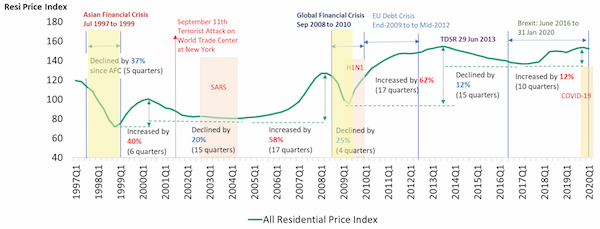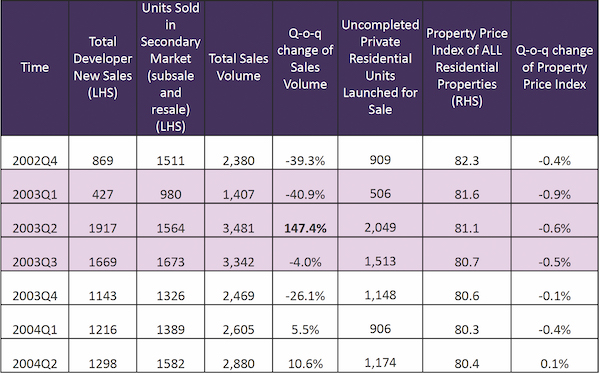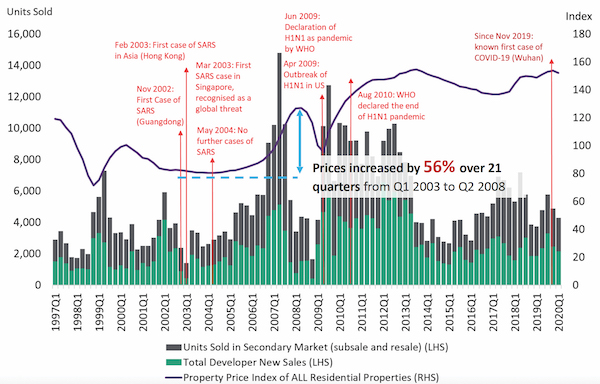Singapore’s private home prices likely to rebound after Covid-19
By Charlene Chin
/ EdgeProp Singapore |

SINGAPORE (EDGEPROP) - Private home prices in Singapore are likely to recover and surpass their past levels after Covid-19 has passed. Citing historical data, Alice Tan, senior director, research & consulting at Edmund Tie & Co, says private residential prices have typically rebounded higher from their previous peaks.
During the Asian Financial Crisis, which occurred from 1997 to 1999, residential prices in Singapore declined 37% over five quarters, followed by an increase of 40% across six quarters. The Global Financial Crisis, which took place from 2008 to 2009, saw prices fall by 25% across four quarters, after which they rebounded 62% across 17 quarters, notes Tan.
“Our private residential prices seem to rebound [after each slump], and when they rebound, they rebound higher and longer,” said Tan at the webinar on “Investing in the Time of Covid-19” on May 30, jointly organised by The Edge Singapore and EdgeProp Singapore.
Advertisement

Impact of global economic crises: After every crisis, residential prices rose higher from previous peaks
(Source: VARIOUS SOURCES, URA, EDMUND TIE RESEARCH)
Covid-19 vs past health crises
As a result of Covid-19, private home prices in Singapore fell by 1% y-o-y in 1Q2020. GDP marked a 0.7% y-o-y contraction in the same period, while tourist numbers plunged by 43.3% y-o-y, to 2.66 million visitors.
Rents, however, increased by 1.1% y-o-y over the same quarter. Tan attributes the rising rental demand to the need for temporary accommodation, which catered to overseas guests and expats who could not travel home, and for quarantine purposes, says Tan.
Amid the SARS outbreak, which occurred from November 2002 to May 2004, Singapore’s GDP grew 4.5% in 2003. The tourism sector brought in 6.1 million visitors to the country in the same year, clocking a 19% fall. This happened because people were fearful of travelling, especially into Asia, as SARS was raging on in the region, notes Tan.
Private residential prices did not register a big decline then, recording a 2.1% y-o-y fall by 4Q2003, says Tan. The rental index, meanwhile, fell by 5% y-o-y. Prices recovered only after six quarters, she notes.
Globally, the number of SARS cases hit about 8,100, with the number of deaths at 774.

Impact of SARS: During the peak of SARS from 1Q2003 to 3Q2003, home prices corrected by less than 1% per quarter, and saw a strong rebound of 147% for private home sales in 2Q2003
(Source: VARIOUS SOURCES, URA, EDMUND TIE RESEARCH)
Meanwhile, the H1N1 pandemic, which happened from April 2009 to May 2010, saw Singapore’s private home prices fall by 1.7% y-o-y in 4Q2009, while rents declined by 14.6% y-o-y in the same quarter. Tan says it took one quarter before property prices began to recover, boosted by the record low interest rates due to the US Federal Reserve’s quantitative easing measures.
Weathering the effects of H1N1, Singapore’s tourism sector attracted 9.7 million visitors in 2009, a 43% y-o-y fall. GDP grew 0.1% in the same year. H1N1 infected as many as 700 million people globally, Tan estimates, with a reported total of 18,500 deaths.
Advertisement
Except for H1N1, health crises have disrupted the sales volume of private homes in Singapore at the start of each outbreak, says Tan. In 1Q2020, sales volume fell by 12.5% q-o-q due to the coronavirus pandemic. Likewise, during SARS, sales volume plunged by 41% q-o-q in 1Q2003.
However, in the following quarter, there was a strong rebound of 147% for private home sales, with 3,481 units sold in the new sales and secondary markets. Price changes in both markets were also “less volatile” and therefore showed “some resilience”, Tan says. She points out that during the peak of SARS — from 1Q2003 to 3Q2003 — private home prices in fact corrected only by less than 1% q-o-q.
Home-buying patterns
Although physical viewings for properties have been halted, and showflats have had to close, April still recorded a total of 523 homes sold. Of those, there were altogether 139 homes purchased in the prime districts of 9, 10 and 11, with Singaporeans making up the bulk of buyers at 82%.
The proportion of homes purchased in Districts 9, 10 and 11 also increased to 27% in April, out of islandwide transactions, compared to 12% in 1Q2020. “Does it mean that people are actually looking at prime districts? And they take the opportunity to buy when everybody is fearful? Potentially so,” says Tan.
Elsewhere, buyers are purchasing homes based on needs and affordability, highlights Tan. In Singapore’s city fringe, or the Rest of Central Region (RCR), average psf price for new home sales went up by 6.1% y-o-y in 1Q2020. Resale prices for the region across the same period showed a marginal drop of 0.7% y-o-y.
Advertisement
This is also mirrored in the suburbs, or Singapore’s Outside Central Region (OCR), where the average psf price for new homes rose by 4.1% y-o-y in 1Q2020. Resale prices, meanwhile, fell by 1.1% y-o-y over the same period.

Impact of pandemics: Disruption to property sales volumes at the start of health outbreaks
(Source: URA, EDMUND TIE RESEARCH)
On the other hand, the average psf price of new homes in Singapore’s Core Central Region (CCR) fell 7% y-o-y in 1Q2020. This fall in prices could be due to the type of projects that were newly launched over the period, which were mostly leasehold and not in the prime areas of Singapore, explains Tan. This is a contrast to 1Q2019, when a lot of the projects launched were on freehold tenures and in very prime locations, she adds.
The property market in Singapore is likely to go through more twists and turns, with the spread of the pandemic yet to be controlled. “Covid-19 is far more worrying as compared to SARS, due to its highly infectious nature. The number of cases are still increasing worldwide, and we are still not out of the woods,” says Tan.
See also The Edge Singapore, Pages 18 & 19, for more reports on the webinar, “Investing in the Time of Covid-19”.
Read also:
https://www.edgeprop.sg/property-news/singapore%E2%80%99s-private-home-prices-likely-rebound-after-covid-19-0


Follow Us
Follow our channels to receive property news updates 24/7 round the clock.
Subscribe to our newsletter
Advertisement
Advertisement
Advertisement
Top Articles
Search Articles